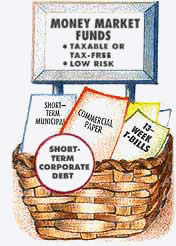Different between Capital Market vs Money Market
Hasil ehsan dari http://www.differencebetween.info/difference-between-money-market-and-capital-market
 When it comes to business, each business at a certain point has to borrow money in order to keep running business. There are multiple ways that a company can borrow money, including issuing bonds, shares or taking up a loan. There are two different components of the financial market; known as Money Market and Capital Market. These terms are more commonly come across in business and economics.
When it comes to business, each business at a certain point has to borrow money in order to keep running business. There are multiple ways that a company can borrow money, including issuing bonds, shares or taking up a loan. There are two different components of the financial market; known as Money Market and Capital Market. These terms are more commonly come across in business and economics.
 A capital market is a component of a financial market that allows long-term trading of debt and equity-backed securities. Long-term borrowing or lending is done by investors or corporations that have large amounts of wealth at their disposal. The most popular capital market is the NYSE or the New York Stock Exchange. Huge financial regulators are responsible for overseeing the capital market to ensure that companies do not defraud their investors. Trading can be done by a number of credit instruments such as stocks, shares, equity, debentured, bonds, and securities. Much of the trading is actually done online using a computer. There is no actual cash involved in trading.
A capital market is a component of a financial market that allows long-term trading of debt and equity-backed securities. Long-term borrowing or lending is done by investors or corporations that have large amounts of wealth at their disposal. The most popular capital market is the NYSE or the New York Stock Exchange. Huge financial regulators are responsible for overseeing the capital market to ensure that companies do not defraud their investors. Trading can be done by a number of credit instruments such as stocks, shares, equity, debentured, bonds, and securities. Much of the trading is actually done online using a computer. There is no actual cash involved in trading.
p/s: Senang sy nak refer balik :) Sharing is caring ^_^
Lots of love. wanizati :)
Key Difference: Money market is a component of financial market where short-term borrowing can be issued. This market includes assets that deal with short-term borrowing, lending, buying and selling. A capital market is a component of a financial market that allows long-term trading of debt and equity-backed securities. Long-term borrowing or lending is done by investors or corporations that have large amounts of wealth at their disposal.
 When it comes to business, each business at a certain point has to borrow money in order to keep running business. There are multiple ways that a company can borrow money, including issuing bonds, shares or taking up a loan. There are two different components of the financial market; known as Money Market and Capital Market. These terms are more commonly come across in business and economics.
When it comes to business, each business at a certain point has to borrow money in order to keep running business. There are multiple ways that a company can borrow money, including issuing bonds, shares or taking up a loan. There are two different components of the financial market; known as Money Market and Capital Market. These terms are more commonly come across in business and economics.
Money market is a component of financial market where short-term borrowing can be issued. This market includes assets that deal with short-term borrowing, lending, buying and selling. The short-term ensures that the borrowing and lending period has a lease of less than one year. The lease can also be as short as a one hour, depending on the borrower and the lender. According to The Global Money Markets, Trading is usually done over the counter using instruments such as Treasury bills, commercial paper, bankers' acceptances, deposits, certificates of deposit, bills of exchange, repurchase agreements, federal funds, and short-lived mortgage-, and asset-backed securities. The money market was created as some businesses has a surplus of cash, while the other businesses were looking for loans.
In the United States, all federal, state and local governments issue papers that are traded in form of money. These include municipal paper and Treasury bills. The main functions of Money market include: Transfer from parties with surplus funds to parties with a deficit, transfer of large sums of money, help to implement monetary policies, determine short-term interest rates and allow government to raise funds. The interest rates in a Money market are also high as the borrowing time is low. Trading in the money markets are usually done by banks or companies with high credit ratings.
 A capital market is a component of a financial market that allows long-term trading of debt and equity-backed securities. Long-term borrowing or lending is done by investors or corporations that have large amounts of wealth at their disposal. The most popular capital market is the NYSE or the New York Stock Exchange. Huge financial regulators are responsible for overseeing the capital market to ensure that companies do not defraud their investors. Trading can be done by a number of credit instruments such as stocks, shares, equity, debentured, bonds, and securities. Much of the trading is actually done online using a computer. There is no actual cash involved in trading.
A capital market is a component of a financial market that allows long-term trading of debt and equity-backed securities. Long-term borrowing or lending is done by investors or corporations that have large amounts of wealth at their disposal. The most popular capital market is the NYSE or the New York Stock Exchange. Huge financial regulators are responsible for overseeing the capital market to ensure that companies do not defraud their investors. Trading can be done by a number of credit instruments such as stocks, shares, equity, debentured, bonds, and securities. Much of the trading is actually done online using a computer. There is no actual cash involved in trading.
Investments made in a capital market usually last longer than a year and can even last up to 25-30 years. Some investments may depend on the life of the company, with the investment ending if the company shuts down. A benefit of this investment is that if need arises, the investor can swiftly cash their investment. Capital market can be divided into two divisions: stock markets and bond markets. In stock markets investors acquire the ownership of the company they are investing in, while in bond markets investors are considered as creditors. Investment done in capital markets are usually for acquiring physical capital goods that would help increase its income. However, generating an income may take anywhere from a couple of months to many years or could even fall through.
Money Market
|
Capital Market
| |
Definition
|
Is a component of the financial markets where short-term borrowing takes place
|
Is a component of financial markets where long-term borrowing takes place
|
Maturity Period
|
Lasts anywhere from 1 hour to 90 days.
|
Lasts for more than one year and can also include life-time of a company.
|
Credit Instruments
|
Certificate of deposit, Repurchase agreements, Commercial paper, Treasury bills, Money funds, Foreign Exchange Swaps, short-lived mortgage and asset-backed securities.
|
Stocks, Shares, Debentures, bonds, Securities of the Government.
|
Nature of Credit Instruments
|
Homogenous. A lot of variety causes problems for investors.
|
Heterogeneous. A lot of varieties are required.
|
Purpose of Loan
|
Short-term credit required for small investments.
|
Long-term credit required to establish business, expand business or purchase fixed assets.
|
Basic Role
|
Liquidity adjustment
|
Putting capital to work
|
Institutions
|
Central banks, Commercial banks, Acceptance houses, Nonbank financial institutions, Bill brokers, etc.
|
Stock exchanges, Commercial banks and Nonbank institutions, such as Insurance Companies, Mortgage Banks, Building Societies, etc.
|
Risk
|
Risk is small
|
Risk is greater
|
Market Regulation
|
Commercial banks are closely regulated to prevent occurrence of a liquidity crisis.
|
Institutions are regulated to keep them from defrauding customers.
|
Relation with Central Bank
|
Closely related to the central banks of the country.
|
Indirectly related with central banks and feels fluctuations depending on the policies of central banks.
|
p/s: Senang sy nak refer balik :) Sharing is caring ^_^
Lots of love. wanizati :)

Comments